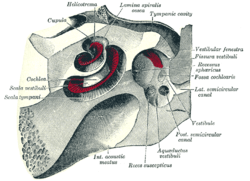Hemotympanum
Hemotympanum or hematotympanum, refers to the presence of blood in the tympanic cavity of the middle ear. Hemotympanum is often the result of basilar skull fracture.[1]

Hemotympanum refers to the presence of blood in your middle ear, which is the area behind your eardrum. In most cases, the blood is trapped behind your eardrum, so you won’t see any blood coming out of your ear.
Treating hemotympanum depends on the underlying cause, so it’s important to tell your doctor about any additional symptoms you have. If you’ve recently injured your head and notice symptoms of hemotympanum, call your doctor immediately to avoid any other complications.
Presentation
- The most common symptoms of hemotympanum are:
- pain
- sense of fullness in the ear
- hearing loss
Causes
- Basal skull fracture
- A basal skull fracture is a fracture in one of the bones at the base of your skull. This is almost always caused by something hitting your head, a hard fall, or a car accident.
If your temporal bone is involved, you may have hemotympanum along with:
- cerebrospinal fluid (CSF) coming out of your ear
- dizziness
- bruising around your eyes or behind your ears
- facial weakness
- difficulty seeing, smelling, or hearing
Skull fractures usually heal on their own, but it’s important to get immediate medical treatment because they can also cause several complications. If you have CSF leaking out of your ear, for example, you’re at a higher risk of developing meningitis. You may also need corticosteroids, antibiotics, or surgery, depending on your symptoms.
Nasal packing
If you’ve had surgery around your nose or frequently get a bloody nose, your doctor may insert gauze or cotton up your nose to stop the bleeding. This process is called therapeutic nasal packing.Nasal packing sometimes causes blood to back up in your middle ear, causing hemotympanum. If you’ve recently had nasal packing done and notice hemotympanum symptoms, contact your doctor. They can remove the packing to allow the blood to drain out of your ear. You may also need antibiotics to avoid getting an ear infection.
Bleeding disorders
Bleeding disorders, such as hemophilia or idiopathic thrombocytopenia purpura, can also cause hemotympanum. These disorders prevent your blood from properly clotting, making you more prone to bleeding. If you have a bleeding disorder, a mild head injury or simply sneezing too hard can cause hemotympanum. If you have a bleeding disorder and have hemotympanum symptoms, let your doctor know. In most cases, they’ll just want to keep an eye on it. They may also prescribe antibiotics to prevent an ear infection.
Anticoagulant medications
Anticoagulants, often called blood thinners, are medications that keep blood from clotting as easily. They are often used to treat blood clots. You might also take them if you have a condition that increases your risk of having a blood clot. In rare cases, anticoagulants can cause hemotympanum without any underlying cause or injury. If you do injure your head while taking them, you’re also more likely to have hemotympanum. If this happens, your doctor might suggest you stop taking anticoagulant medication for a brief period of time while your ear heals. However, make sure you talk to your doctor before you stop taking any prescribed medications. You may also need antibiotics to avoid an ear infection.
Ear infections
If you have frequent ear infections, ongoing inflammation and fluid buildup can increase your risk of developing hemotympanum. Work with your doctor to come up with a treatment plan for recurring ear infections. In most cases, you’ll just need antibiotics or eardrops. However, some cases may require surgery to prevent future infections.
References
- . It may also be secondary to fractures of the mandibular condyles. Blueprints Neurology, 2nd ed
- James Mucendu RCO